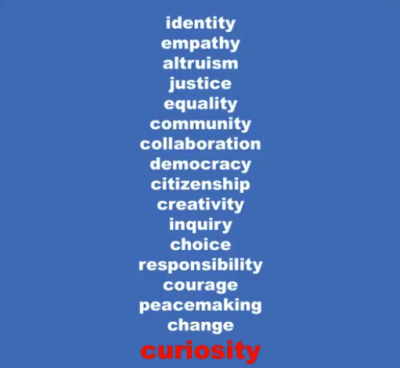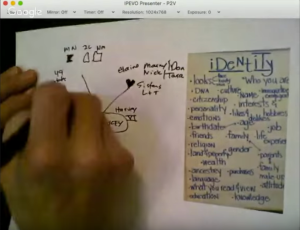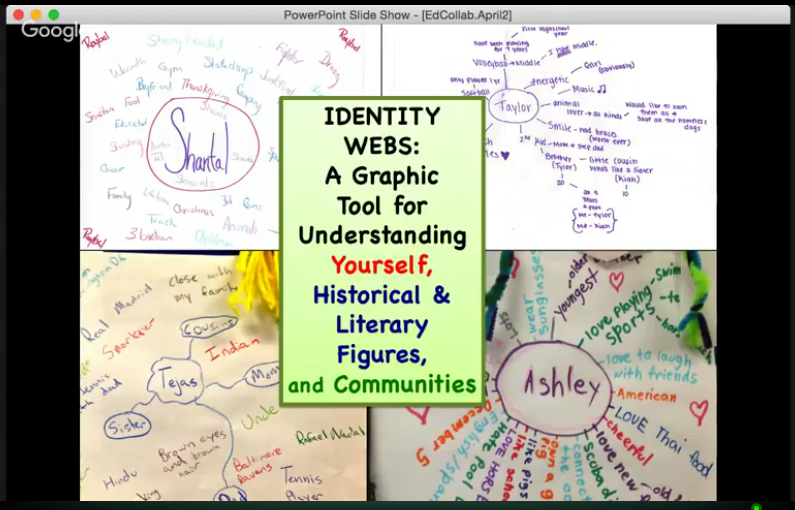“I think my head is going to explode.”
And that generally sums up how I felt during the Educator Collaborative Spring Gathering yesterday—and that was just after the opening keynote! One after another, each session offered many things for me to think about. Yesterday was a day filled with so many important reminders—reminders of best practices to hold on to in the messiness of daily teaching (and believe me, it gets messy). But it was also a day to gather new ideas—ideas that I know I will take into my classroom this week and the weeks and months to come. So before I go any further, a HUGE thank you to all the presenters, organizers, and team at the Educator Collaborative.
The gathering consisted of opening and closing keynotes, plus 17 additional workshops offered over the course of four session times. This meant that you could watch six workshops live, and I was able to watch both keynotes and two workshops. Thankfully, the team at the Educators Collaborative have archived all the workshops online, which means I’ve got more opportunities for PD in my PJs in the upcoming weeks as I catch up on what I missed.
So before the new school week begins, I wanted to write down some of my notes—many of them curated from my Twitter feed. And because I learned so much from each session, I’m posting my reflections on each session in a separate blog posts later.
So without further delay, my thoughts on the opening keynote…

This was actually the first time that I had the chance to see Harvey Daniels and Sara Ahmed present—and it did not disappoint! In their opening keynote, they reminded the audience of how important it is for teachers to know their students. Daniels pointed out how we need to make sure that our classrooms are places that students should feel welcomed and valued, from day one. He and Sara shared pictures of many of the classrooms that they’ve visited in their travels. This virtual tour through outstanding teachers’ classrooms was not only inspiring, but also reminded me of how important our learning spaces truly are. As Daniels pointed out, “We want our classrooms to look more like family rooms than industrialized spaces.”
Even before I saw this session, I had been thinking about the issue of classroom space—more specifically, what does the space in my classroom tell students about the type of learning that will happen (or not happen) within its four walls. As some of my colleagues know, I’ve been on a mission trying to figure out how to get rid of all the desks in my classroom and replace them with tables and chairs. I want the space in the room to be open and flexible, to allow for the many different types of learning that can and should be happening on any given day. When I read Atwell’s In the Middle and Ariana Sacks’ Whole Novels for the Whole Class last summer, I was struck by how much care they put into their physical learning environments—how they carved out distinct spaces for a variety of learning tasks, from whole or small-group mini lessons to writing workshop space to reading zones.
I’ve tried to do the best I can with my desks by clustering them into an arrangement that encourages more collaborative conversation, but those desks are hard to maneuver (and move every 43 minutes). As a colleague recently joked, the rigidity of the desks are almost like being trapped in an educational straight jacket. While he meant that as hyperbole (and it is), he has a point. (More on the idea of flexible spaces and active learning classrooms in a future post.)
 Of course, the opening keynote didn’t just discuss classroom spaces. The pictures of teachers’ classrooms did, however, make visible the important learning happening in those classrooms. And one thing that was immediately visible was that these were classrooms where curiosity and wonder were encouraged and nurtured. Daniels shared a list (right) of the types of learning that he has not yet found in any curriculum mandates or Common Core standards.
Of course, the opening keynote didn’t just discuss classroom spaces. The pictures of teachers’ classrooms did, however, make visible the important learning happening in those classrooms. And one thing that was immediately visible was that these were classrooms where curiosity and wonder were encouraged and nurtured. Daniels shared a list (right) of the types of learning that he has not yet found in any curriculum mandates or Common Core standards.
He went on to emphasize how a priority in education must be to nurture student curiosity. Citing research from Harvard University, Daniels pointed out that the number of “curiosity episodes” a child has drastically diminishes the longer he is in school. Pre-K students have, for example, between 26-76 curiosity episodes/hour so that “every half a minute to a minute, they’re doing something curious.” By the time students got to kindergarten, their curiosity episodes dropped to 1/hour, and by 5th grade, the number is too small to even measure. Daniels cited Susan Engel, the Harvard researcher, with this astonishing observation:
Most children spend their whole school day without asking a single question or engaging in a sequence of behavior aimed at finding out something new.
This transition is like moving from an intrepid explorer to a well-behaved scholar.
From an intrepid explorer to a well-behaved scholar. Yes. Too often, the longer students are in school, the more they assimilate to a system that rewards compliance. But, as Amy Rasmussen reminded me in her session later that day, “Compliance is not engagement.” Too many of our students are “excellent sheep,” a term that Yale professor William Deresiewicz uses to describe the current generation of students in our classroom—eager to please, but lacking self-direction. Daniels also drew from brain research done at the UC-Davis that revealed that when people are “curious about a subject, they not only remember more about it, but they also remember all the random or incidental information presented along the way.” In other words, curiosity heightens our ability to take in new information.

Daniels also made this significant point. When students are curious and engaged, they also self-regulate. Students’ energies focus on satisfying their curiosities. But we have to give them opportunities to be curious and to harness those curiosities in ways that make them more sophisticated thinkers and more responsible citizens.
During the session, I was reminded of something that Will Richardson recently wrote for the Huffington Post:
As learners ourselves, we know that real learning that sticks with us over time occurs when it’s built on passion, when it has an authentic purpose and audience, when it’s relevant to our lives in the moment and beyond, when it’s not constrained by time, and more. This isn’t rocket science. Yet generally in schools, we provide few if any of those conditions that we know are required for that type of deep learning to take place. We don’t let students pursue the questions most in their minds. More often than not, the sole audience for the work students do is the teacher, and it serves no real world, authentic purpose. Our kids’ passions and interests are ignored in favor of compliance to the curriculum.
Richardson goes on to clarify the real issue at stake:
The real innovation, instead, is in relearning why we want kids in schools in the first place. As author Seymour Sarason says, the overarching purpose of school ought to be that children should want to keep learning more about themselves, others, and the world when they leave us.
Thus, our task as educators must be to honor the spirit of the “intrepid explorer” in our students. We need to find regular, daily ways that students can express their wonders, whether it’s through wonder walls in the classroom space or using padlets and Wonderopolis online. We need to give students the opportunities to deliberately reflect on the questions they have about themselves and their world. Here, for example is Sara Ahmed’s “Wonders in my World” list:


Watching a master teacher model a strategy!
In addition to their emphasis on curiosity, Daniels and Ahmed shared the strategy of creating identity webs; in fact, what a treat it was to be able to see Daniels model the strategy live for the audience. These webs can provide the most important information we need about our students early in the school year. As Ahmed pointed out, “When you invest in kids, you get the greatest return for your investment.”
Of course, the other benefit to having students create identity webs is that the simple act of reflecting on who we are as individuals can also help us read the world more deeply. We want students to consider the factors in their lives—in their identity webs—that affect the way they see and interpret the world. Knowing who we are can help us understand why we read the world in the ways that we do. This is the essential skill needed of all people in a democracy.

My key takeaway from Daniel and Ahmed’s session? Though there are too many to count, the lasting impression that I felt, deep in my bones, after watching their session was their relentlessly humanistic approach to teaching. Over and over again, in the strategies they shared, they put kids first—nurture their curiosities, allow them time and space to develop inquiry.
I could think of no better way to start the day than by putting these issues up front and centered.
Big Questions to Consider:
- How do I make “curiosity episodes” a daily part of my classroom environment? How can I make what students wonder about the center of their learning?
- How can I use identity webs as a way for students to understand the concept of “stance”? How can I help them see the world from various stances?
Pingback: #TheEdCollabGathering | Resource - Full
How do you find out about all of these wonderful PD sessions and speakers? I know one of the best ways for me to feel rejuvenated in my practice is by listening to other passionate educators (hence my avid love for your blog). How else can I find out what’s going on in the Philadelphia area that I can attend? I know about the PAWLP sessions and get those emails. What about others? Thank you, also, for your incredibly detailed and thoughtful post on that first session. It sounds like it was so powerful. I’m glad to have lived through it, at least in part, through you.
LikeLiked by 1 person
Thanks, Rachel! I’m enjoying reading your thoughts on some of my blog posts this morning! 🙂
As far as finding out about all this PD, part of it is definitely through PAWLP, but much of it is through Twitter and in particular, in the connections/people I’ve “met” through Twitter. So many good ideas out there and plenty of people willing to share! If you’re not already on there regularly, I would highly suggest it! Participating in a few chats are a good way to start.
LikeLiked by 1 person
Also, check out PCTELA and KSRA, if you haven’t already. I’m planning on going and hopefully presenting at one or both in the Fall. Donalyn Miller will be at KSRA, too, so I’m really looking forward to hearing her speak! One conference I wish I could attend is the Scholastic Reading conference in DC this summer. Nancie Atwell is keynoting!
LikeLiked by 1 person